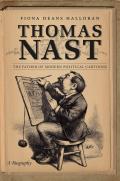Making Space for Thomas Nast
Early this year, folks at the Massachusetts Historical Society contacted me and colleagues in the Boston Comics Roundtable and invited us to help create part of a new exhibit on political cartoons in American history.
Our role would be to depict the life of Thomas Nast, the leading American political cartoonist of the late nineteenth century, in a series of new drawings. A particular room in the MHS’s handsome building on Boylston Street was reserved for this part of the exhibit.
That room is round. It has two doors, three large windows, and a fireplace. There’s handsome wooden paneling up to about chest height. In other words, it’s not a simple box with off-white walls ready to be a neutral enclosure for art.
Measuring the room and the available materials, I mapped out a display customized for that space. There would be nine rectangular panels around the edge of the room, one with introductory text and eight with cartoons tracing Nast’s life. Each new cartoon would incorporate Nast’s own artwork, either within the scene or as inspiration, showing the course of his career.
As for the room’s quirks, I made them part of the display. The three cartoons set in the tall window spaces, depicting the height of Nast’s influence, would be augmented above and below with reproductions of his own caricatures and icons. Beside the fireplace would stand a cut-out of one of Nast’s famous drawings of Santa Claus. In the center of the room, a display case would showcase Nast’s pages for Harper’s Weekly from the MHS collection. It was a pretty clever scheme, if I say so myself.
My colleagues recruited artists while I researched Nast’s life to find iconic moments and details. While there are many collections of his artwork, the best sources for biographical detail were Albert Bigelow Paine’s 1904 Th. Nast: His Period and His Pictures, based on conversations with the artist and published soon after his death, and Fiona Deans Halloran’s thorough, nuanced study, Thomas Nast: The Father of Modern Political Cartoons.
Then the virus arrived. We all hunkered down in our houses for a while. I continued the research. In fact, I’d just taken a bunch of Nast books out from the local library, and all their due dates were helpfully extended, and extended again. On eBay I found Nast’s first published print for Frank Leslie’s Illustrated Newspaper, cheap because the seller hadn’t recognized the artist. Some of my early ideas for cartoons didn’t work out. The MHS asked for more Massachusetts content. I revised and polished with my collaborators’ help.
And then the virus stayed around. The MHS decided its building had to stay closed to the public through the fall. The exhibit built around a particular space would not appear in any space at all.
COMING UP: Back to the drawing board.



No comments:
Post a Comment